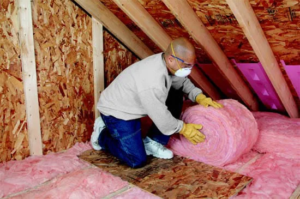Gutter Guard Charleston is an excellent choice for homeowners who want to reduce their maintenance tasks and protect their homes from water damage. They can block leaves, pine needles, twigs, and other debris that would otherwise clog gutters. This helps homeowners save time and avoid climbing ladders frequently.
They also keep shingle roofs safe from debris, keeping them in good condition and preventing the need for costly repairs.

Gutter guards are a cost-effective way to reduce the frequency of gutter cleaning, saving money and time. They also help prevent clogs, which can cause water damage to your foundation, basement, roof, and landscaping. Clogged gutters can also lead to harmful mould growth, which can affect health in the young and elderly. Home insurance companies typically do not cover damage caused by clogged gutters, but the purchase of gutter guards can protect your property from such damage.
There are many different types of gutter guards available, ranging from foam inserts to stainless steel mesh. Each type has its own benefits and drawbacks. For example, foam inserts are affordable and easy to install, but they often clog over time. They also promote seed trapping and sprouting, which can be problematic for your gutter system over time. On the other hand, stainless steel mesh gutter guards are more durable and require less maintenance. They also keep out larger debris, but they are more expensive.
Another option is a gutter guard with a curved design, which uses surface tension to direct water into the gutters while keeping out debris. However, it can be difficult to clean and may need regular maintenance. In addition, it can create mold and mildew in the inside of the gutters. This can lead to rot and leaks in the roof and fascia boards.
The cost of installing gutter guards can vary widely depending on the type and complexity of the project. Generally, the cost can range from $2 to $6 per linear foot. However, the price can be higher for houses with multiple stories. This is mainly due to the need for extra safety equipment and labor costs.
In general, it is best to use a professional for the installation of gutter guards. This will ensure that the job is done correctly and that it will last for a long period of time. In addition, a professional will be able to recommend the best type of gutter guard for your home. The professional will also be able to handle any challenges that may arise during the installation process, which will save you time and money.
Easy to install
Gutter guards are an easy way to protect your home from water damage. They can be installed by a professional or you can do them yourself. They are also affordable and can save you money in the long run. They are a great investment in your home. You should look for a quality gutter guard system that is sturdy and durable, and will not clog easily.
One of the best things about these guards is that they eliminate the need for cleaning your gutters. They are designed to keep the natural pitch of your roof and are made of metal or aluminum. This means that leaves, twigs, pine needles, and other debris will fall to the ground rather than getting caught in your gutters. In addition, these guards are not visible from the ground. They are also available in a variety of color options to match your home’s design.
However, while these guards do reduce the frequency of cleaning your gutters, they are not maintenance-free. They still need to be cleaned periodically, especially if there are large amounts of debris on the top of them. In addition, some types of gutter guards may not perform well in extreme weather conditions, such as heavy ice or rain.
If you are thinking about installing gutter guards, it’s important to find a company that is experienced and licensed in your area. This will ensure that your contractor is qualified to install the product and will not use inferior materials. Also, make sure to ask about a warranty and guarantee. A good company will offer a warranty on their work and can refer you to previous customers who can testify about their expertise.
The A-M 5-inch aluminum gutter guard is an excellent choice for those looking for a high-quality product that will not clog easily. It contains 380 1/8-inch holes per linear foot to handle heavy downpours. It’s also available in several colors and can be installed over existing gutters. This guard is a low-cost option for those who want to avoid the hassle of climbing ladders to clean their gutters.
Reduces cleaning frequency
Gutter guards are an effective way to prevent blockages, water damage, mold growth and pest infestation. They also help homeowners save money on expensive gutter cleaning services and time. However, it is important to understand that these systems are not completely maintenance-free. They should be inspected semi-regularly and after major storms. Nevertheless, they can significantly reduce the frequency of cleaning. Gutter guards can also prevent the need for frequent replacement of gutter components due to rusting and rot.
Clogged gutters can cause a number of problems, including unsightly streaks on home siding, flooding in basements and foundations, soil erosion in landscaping, and the occurrence of dangerous black mold. Gutter guards can greatly reduce the frequency of cleaning, thereby saving you money and protecting your home from costly damages.
In addition, they can keep outdoor debris out of the gutter system, preventing the growth of mold and mildew. This can also protect the roof from sagging and pulling away from the house. Furthermore, gutter guards can eliminate the need to climb ladders for cleaning. Ladder-related falls are a common cause of serious injuries that require expensive medical treatment.
Lastly, gutter guards can also prevent fires from spreading to the home. Gutters naturally collect combustible debris, such as twigs and leaves. This debris can ignite during wildfires, causing extensive and costly fire damage. Gutter guards can prevent these problems by removing combustible debris from the gutters, which can significantly reduce the risk of fires and protect the home from embers carried by wind.
When choosing a gutter guard, it is important to consider the type of climate you live in. For example, you may need a more durable gutter guard that can withstand heavy rains. In addition, you should choose a gutter guard that is designed to be compatible with your type of roof and yard. In addition, you should hire a professional for installation to ensure that the system is properly installed and functioning correctly. The cost of gutter guards varies depending on the material, design complexity, and installation costs. However, the initial investment can save you money on regular cleaning and repair bills, as well as increase your home’s value.
Increases home value
Gutter guards can add value to a home by reducing maintenance costs and preventing expensive repairs due to water damage. However, homeowners should carefully consider their unique environmental conditions, gutter type, roof type and budget before installing a gutter protection system. Different types of gutter guards are available to meet a wide variety of needs, ranging from basic metal guards to micro-mesh systems designed for maximum performance and longevity.
One of the biggest benefits of gutter guards is that they reduce cleaning frequency. Though not entirely maintenance-free, they minimize the need for frequent gutter cleaning by blocking branches, twigs, pine needles and leaves from entering the gutter. This helps to protect the gutters, preventing clogs and promoting water flow into downspouts and away from the house.
The other main benefit of gutter guards is that they prevent overflow and water leakage, which can damage the siding of a home. Overflowing and clogged gutters also lead to moisture buildup in the foundation of a home, which can cause rot or mold. These problems can be very expensive to fix, and can affect the overall value of a property.
Many people choose to install gutter guards on their own to save money, but this can be dangerous. It is important to hire a professional installer who can assess the condition of the gutters and recommend the right solution. They will inspect the site and provide a written estimate for the work. They will also take into account any obstacles that may interfere with safe ladder positioning, such as trees or complex landscaping features. They will also consider the number of stories in a building, as these can increase the cost of installation by requiring additional labor.
In addition to increasing a property’s value, gutter guards can help prevent damage to a home’s structure and improve curb appeal. They also prevent water damage and stains from rainwater accumulation in the foundation, which can be costly to repair. Gutter guards can also increase a home’s energy efficiency by keeping it dry and eliminating the risk of mold and mildew.








